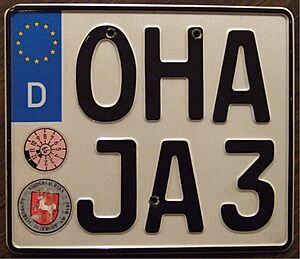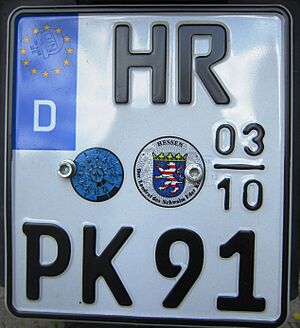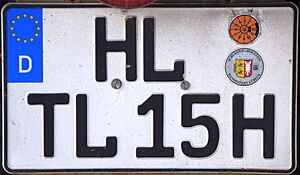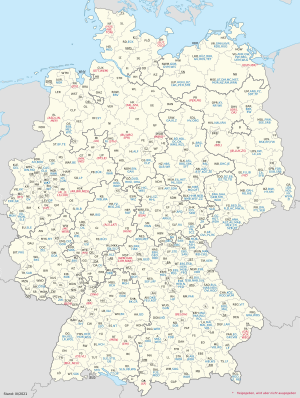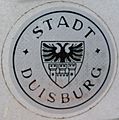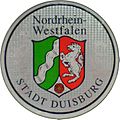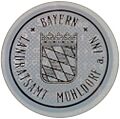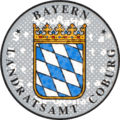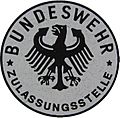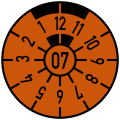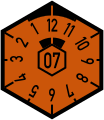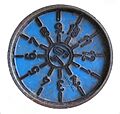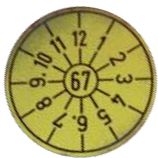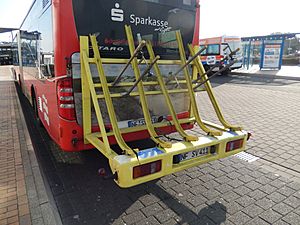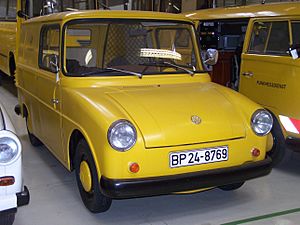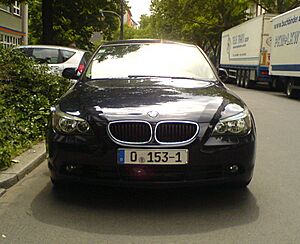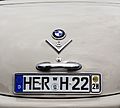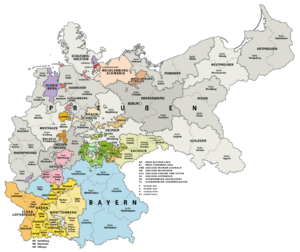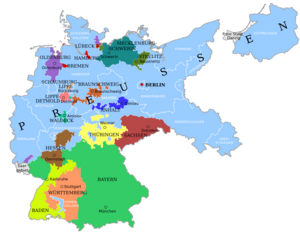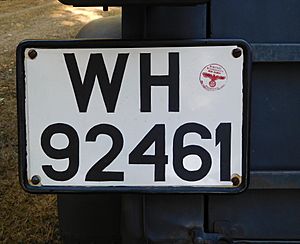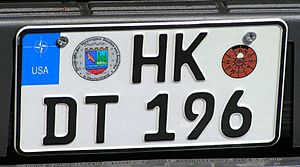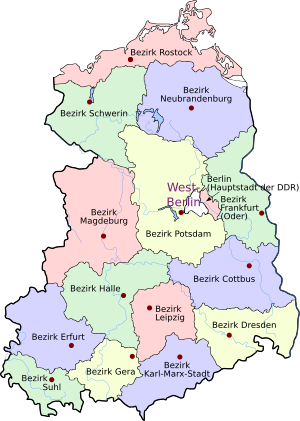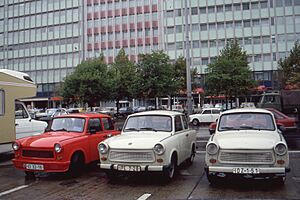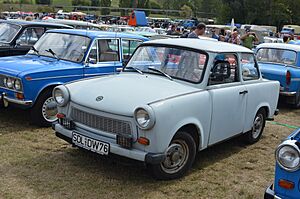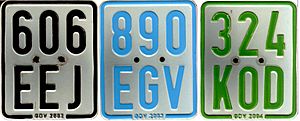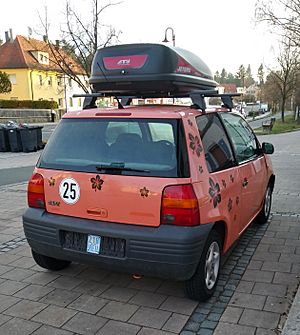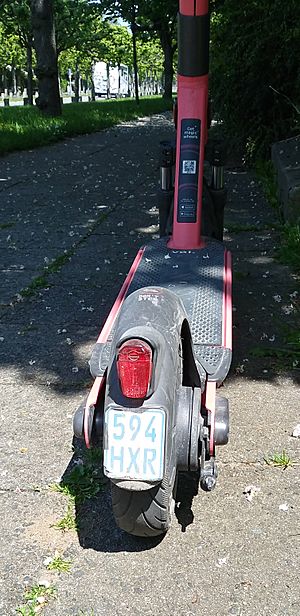Vehicle registration plates of Germany facts for kids



Vehicle registration plates (also called Nummernschilder in German) are special signs with letters and numbers. They are required for all vehicles in Germany. These plates show a vehicle's unique registration mark. Germany has used these plates since 1906, with the current system starting in 1956. District offices officially issue these plates.
Every motorized vehicle on public roads, whether moving or parked, must have its assigned plates. These plates are placed at the front and back of the vehicle. Special seals on the plates show they are valid. Motorcycles and trailers only need a plate at the back.
A cool thing about German plates is the area code. This code tells you which district the vehicle is from. Many people in Germany, even kids, play a game while traveling to guess where a car is registered!
Contents
- How German License Plates Work
- Parts of a License Plate
- How to Register a Vehicle
- Special Plate Types and Colors
- History of German Plates
- Insurance Plates
- See also
How German License Plates Work
What are the Rules for Plates?
German laws explain all the rules for license plates. The main law is called Fahrzeug-Zulassungs-Verordnung (Vehicle Registration Ordinance). This law talks about the specific letter and number combinations (Kennzeichen) and the actual physical plates (Kennzeichenschilder).
What Do German Plates Look Like?
German plates are usually rectangular. Standard car plates are about 520 mm long and 110 mm high. Plates with fewer characters can be shorter. Some vehicles, like trucks and buses, can have two-line plates (340 mm by 200 mm). Motorcycle plates are also two lines but have different sizes, like 200 mm by 220 mm for newer ones. Smaller plates are used for light motorcycles or special import cars.
The letters and numbers on the plates are black, and the background is white. They also have a thin black border. Standard characters are 75 mm tall. The current system, started in 1956, uses an area code (one, two, or three letters) followed by one or two letters and one to four numbers. A plate can have up to eight characters in total. Motorcycles often use shorter combinations because they have less space for plates.
What Font is Used?
Modern German plates use a special font called FE-Schrift. This font is designed to make it hard to change letters or numbers to look like others. For example, you can't easily change a 'P' to an 'R'. This font also helps computers read the plates easily for automatic recognition.
This style of plate became mandatory in 2000. On the left side of the plate, there's a blue strip. It shows a white 'D' for Germany (Deutschland) and the Flag of Europe (12 golden stars in a circle).
What are Plates Made Of?
Most German plates are made of aluminum. The letters are raised, or "embossed." Since 2013, plastic plates are also allowed. These are said to be tougher and better for the environment to produce, but they cost more.
Plates must reflect light but not be shiny like a mirror. They must also be clean and not covered by anything. Drivers who put stickers on their plates can get fined.
Parts of a License Plate
What is the Area Code?
The first part of the plate is the area code. It has one, two, or three letters. This code tells you the district where the car was registered. For example, B is for Berlin, and HSK is for Hochsauerlandkreis. These codes usually refer to German districts.
In the past, each district had only one code. If districts merged, their code would change for new registrations. But since 2013, many old area codes have been brought back. This means some districts now use more than one code. Also, some codes are used by more than one district.
German codes can include special letters like Ä, Ö, and Ü. For a long time, a code with one of these special letters meant you couldn't have a similar code without it. For example, if 'FÜ' was used, 'FU' couldn't be. But this rule changed in 1996.
-
N plate with two middle letters from Nuremberg city
-
N plate with one middle letter from Nürnberger Land district
How Area Codes Changed Over Time
When area codes first started, police used them to find traffic offenders. But soon, they became a way for people to show where they were from. People sometimes even made fun of codes from nearby districts. When districts merged, there were often big arguments about which old code to keep.
The Büsingen Exclave: A Special Case
There's a special rule for a small German town called Büsingen am Hochrhein. It's completely surrounded by Switzerland. Even though it's part of the German district of Konstanz, cars from Büsingen don't use the 'KN' code. Instead, they use BÜS. This helps Swiss customs officers know it's a local vehicle. Only about 700 cars have this code, making Büsingen the smallest place in Germany with its own unique plate code.
List of Area Codes (Examples)
|
|||||||||||||||||||||||||||||
What are the Stickers For?
Plates become valid when official seals are added. These are round stickers, 45 mm wide. They show the seal of the German state and the name of the district that issued the plate. Older stickers were smaller and only black and white. Vehicles used by federal groups, like the Federal Police, have the German eagle instead of a state seal.
-
Registration seal, City of Duisburg, older version
-
Registration seal, City of Duisburg, North Rhine-Westphalia, newer version
-
Registration seal, Mühldorf am Inn, older version
-
Registration seal, Coburg district, newer version
The rear plate also has a vehicle safety test sticker. This test is required three years after a car is first registered, and then every two years. The sticker shows the month the next test is due by pointing upwards. The year is printed in the middle, and the sticker's color also indicates the year.
Between 1985 and 2010, a hexagonal sticker for emission tests was on the front plate. This test is now part of the safety test, so that sticker is no longer needed. These stickers are designed to be hard to remove without damaging the plate, which helps prevent fakes.
The only plates that don't need these seals are "repeater plates." These are used when the original rear plate is covered by something, like a bike rack.
What are the Serial Letters and Digits?
The last part of the plate is the identifier, which has one or two letters followed by up to four numbers. For example, A1 to ZZ9999 are possible. The total number of characters, including the area code, cannot be more than eight. All 26 letters of the alphabet can be used now. In the past, some letters like B, F, G, I, O, and Q were not allowed in the middle part to avoid confusion with numbers. But this changed over time, and all letters are now allowed.
The space between the area code and the serial letters is important. For example, F ST 683 is different from FS T 683. Police often spell out the area code and then the letters using a special alphabet to avoid mistakes.
Can I Get a Personalized Plate?
Yes! For an extra fee, you can choose your own letters and numbers for the identifier. Many people pick their initials and birth date. For example, if your name is Ulrike Mustermann and you were born on May 2, 1965, in Essen, you might choose E-UM 2565. You can also get creative with words, like a person from Pirna choosing PIR-AT 77 (Pirat means "pirate" in German).
These personalized plates must still follow the general rules. For example, you can't have more than two letters after the area code.
Company Cars and Their Plates
Companies can register their vehicles in different places, sometimes to get a specific license plate. For example, ADAC, a German car club, has all its assistance cars registered in Munich, so they all have an M plate.
Deutsche Bahn, the German railway company, often uses DB as their middle letters, like F-DB for their Frankfurt office. Deutsche Telekom, a big phone company, often uses BN plates (for Bonn, where they started) and prefers the middle letters DT.
BMW, which owns Mini, registers all Mini press cars in the Minden-Lübbecke district (code MI) to get "MI-NI" plates.
Are There Any Forbidden Combinations?
Yes, some letter combinations are not allowed because they are linked to bad historical groups or offensive ideas. For example, combinations like 'NS' or 'KZ' are generally not issued. This rule helps avoid promoting harmful symbols.
Some districts also avoid combinations that could be seen as offensive words. However, some combinations that might have seemed unusual in the past are now allowed. The decision on what is allowed is up to each district office. For example, the Herford district stopped issuing plates with 'HF-Z' in April 2022 to avoid links to the 'Z' symbol used in the 2022 Russian invasion of Ukraine.


What are Reserved Combinations?
Some districts keep certain letter combinations for special uses. For example, the city of Dresden uses DD-Q plates for state police vehicles. Cologne uses K-TX for taxis and K-LN for city-owned vehicles. Firefighter vehicles often get the middle letters FW (for Feuerwehr, meaning fire department).
How to Register a Vehicle
What is the Registration Process?
You must register your vehicle with your name and address. You need to show your ID, vehicle papers, and proof of insurance. The registration happens at the district office where you live. You'll get a letter and number combination for your plate. You then buy the physical plates from a store or online. After that, you go back to the registration office to get the official seals applied. There's a fee for registration, plus the cost of the plates.
All registrations are recorded by the district office and a national register called the Central Vehicle Register (ZFZR). This register keeps track of the vehicle, owner, and insurance details.
If you sell your vehicle or move, you must update the registration. If you move to a different district, you used to have to change your plates. But since 2015, you can keep your old plates. This means the area code on a plate doesn't always show where the owner lives now.
When you want to stop using your vehicle, you must deregister it. The office will damage the seals on your plates to show they can't be used anymore. Once damaged, you can only drive the vehicle directly home. It's usually best to deregister a car when you sell it.
If a car owner doesn't pay their insurance, the police can remove the official seal from the plate. This makes the car illegal to use or park in public. You can only drive it to the registration office to get a new seal once insurance is paid.
How Much Does it Cost?
As of 2020, the average registration fee is about €26. You might pay more if you choose a personalized plate. Plate prices vary, from less than €10 to about €40 per plate. Buying plates online is often cheaper, but getting them made at a shop near the registration office is faster.
You also have to pay vehicle tax (around €194 on average, depending on the car) and mandatory liability insurance (around €260 on average in 2019).
What are Special Registrations?
Besides regular, all-year registration, you can register a vehicle for certain months of the year (seasonal plates) or for a few days (export plates). You can also register two vehicles (like a car and a motorhome) with one main plate. These options can save money on taxes and insurance. There are also special savings for classic cars and electric vehicles. Each special registration has a unique plate style.
Special Plate Types and Colors
Certain vehicles have special codes or colors on their plates.
Plates for Government Vehicles
Vehicles owned by federal, state, or local governments sometimes have plates that don't show a district code.
Plates for Top Government Officials
The German President uses plate 0-1. The Chancellor uses 0-2. The Foreign Minister uses 0-3. The President of the Parliament uses 1-1. These vehicles don't pay tax and are insured by the government.
Plates for Federal Government Offices
The federal government uses the code BD (for Bundesrepublik Deutschland, meaning Federal Republic of Germany) instead of a city code. This is for ministries, parliament, and the president's office.
| Code | Name (German) | Name/Translation (English) |
|---|---|---|
| BD 1 | Bundestag | Bundestag |
| BD 3 | Bundesrat | Bundesrat |
| BD 4 | Bundesverfassungsgericht | Federal Constitutional Court |
| BD 5 | Bundespräsidialamt | Federal Presidential Office |
| BD 6 | Bundeskanzleramt | Federal Chancellery |
| Presse- und Informationsamt der Bundesregierung | Press and information office of the government | |
| BD 7 | Auswärtiges Amt | Federal Foreign Office |
| BD 8 | Bundeszollverwaltung | Federal Customs Administration |
| BD 9 | Bundesministerium des Innern | Federal Ministry of the Interior |
| BD 10 | Bundesministerium der Justiz und für Verbraucherschutz | Federal Ministry of Justice and Consumer Protection |
| BD 11 | Bundesministerium der Finanzen | Federal Ministry of Finance |
| BD 12 | Bundesministerium für Wirtschaft und Energie | Federal Ministry for Economic Affairs and Energy |
| BD 13 | Bundesministerium für Verkehr | Federal Ministry for Transport |
| BD 14 | Bundesministerium für Landwirtschaft, Ernährung und Heimat | Federal Ministry of Agriculture, Food and Regional Identity |
| BD 15 | Bundesministerium für Arbeit und Soziales | Federal Ministry of Labour and Social Affairs |
| BD 16 | Bundeszollverwaltung | Federal Customs Administration |
| BD 18 | Bundesministerium der Verteidigung | Federal Ministry of Defence |
| BD 19 | Bundesministerium für Forschung, Technologie und Raumfahrt | Federal Ministry of Research, Technology and Space |
| BD 20 | Bundesministerium für Umwelt, Klimaschutz, Naturschutz und nukleare Sicherheit | Federal Ministry for the Environment, Climate Action, Nature Conservation and Nuclear Safety |
| BD 21 | Bundesministerium für Bildung, Familie, Senioren, Frauen und Jugend | Federal Ministry of Education, Family Affairs, Senior Citizens, Women and Youth |
| BD 22 | Bundesministerium für Gesundheit | Federal Ministry of Health |
| BD 23 | Bundeskriminalamt | Federal Criminal Police Office |
| BD 26 | Bundesministerium für wirtschaftliche Zusammenarbeit und Entwicklung | Federal Ministry for Economic Cooperation and Development |
Plates for Federal Agencies
Some federal agencies use special prefixes.
- The Technisches Hilfswerk (Federal Agency for Technical Relief) uses THW. Their plates start with 8 or 9 (e.g., THW-80000).
- The Federal Administration of Waterways and Navigation uses BW followed by a number for the region.
- The German Federal Police uses BP (for Bundespolizei). Before 2006, they used BG.
Plates for State Governments

German state governments also have their own codes, similar to the federal government. For example, in North Rhine-Westphalia, the state code is used by the police.
Plates for Public Services
Before 2006, official vehicles like police cars, fire trucks, and city administration vehicles had plates with just the district prefix and a number (e.g., M-1234). This style is mostly no longer issued, but older vehicles still have them.
Plates for Diplomats
Cars with diplomatic immunity have plates starting with 0. This is followed by a two or three-digit number for the country's mission, a hyphen, and another number. A '1' in the last spot usually means it's the ambassador's car. Lower-ranking embassy staff use regular city codes (like B for Berlin) but with the same number pattern.
Plates for the Military
The Bundeswehr (German armed forces) uses non-reflective plates with the German flag instead of the EU strip. They use the letter Y (since no German city starts with Y) followed by a dash and a six-digit number (e.g., Y-123 456). These vehicles are tax-exempt and insured by the government. NATO headquarters vehicles in Germany use the letter X followed by a four-digit number (e.g., X-1234).
Plates with Different Colors
Sometimes, German plates have different colored letters.
Green on White Plates
Vehicles that don't pay vehicle taxes, like ambulances, tractors, or certain trailers, have green letters on a white background.
Red on White Plates (06)
Car dealers use red letters on a white background, and their plates start with 06. These plates can be used for test drives of unregistered cars. The insurance is linked to the plate, not a specific car.
Red on White Plates (07)
Red plates starting with 07 are for collectors of vintage vehicles. These vehicles must be at least 30 years old. Collectors can use one set of these plates on any of their vintage cars, but they must keep a detailed record of when each car is used. These cars are not for everyday use.
Special Plate Formats
"H" for Historic Cars
Classic cars (called Oldtimer in German) can get an H (for historisch, meaning historic) at the end of their plate, like K-AA 100H. This shows the car is a "vehicle of cultural value." It also means a lower flat tax each year. To get an H-plate, the car must be at least 30 years old and mostly original.
"E" for Electric Cars
Since 2015, electric vehicles can get an E at the end of their license number. This helps identify them for special benefits. This applies to all-electric cars and plug-in hybrids with a certain electric range.
Seasonal Plates
Seasonal plates are popular for vehicles used only part of the year, like motorcycles or convertibles in summer. They have two two-digit numbers at the end, showing the start and end months of their validity. This saves money on taxes and insurance.
Interchangeable Plates
You can register two vehicles of the same type (e.g., two cars) with one alternating license plate. Only the last digit changes between the two vehicles. The main part of the plate has the registration seal and a small 'W' (for Wechselkennzeichen). The other part has the technical inspection seal. Both vehicles pay full tax, but insurance might be cheaper.
Temporary Plates
Used vehicles that are not registered can use short-term plates, valid for only five days. These are called "yellow number plates" because of a yellow stripe on the right that shows the expiration date (day, month, year). The numeric code starts with 04. These plates are for driving to a technical inspection or moving the vehicle. Insurance for these plates is expensive. They are only valid within Germany.
Export Plates
Ausfuhrkennzeichen (export plates) are used for sending vehicles abroad. They have a red stripe on the right showing the expiration date of the insurance and tax. After this date, the vehicle must leave Germany.
History of German Plates
Early Days (1906-1945)
The first German license plates with a clear system appeared in 1906. Different states in the German Empire used various prefixes, like Roman numerals or letters. Larger states added more identifiers for their regions.
During World War I, the German Army used 'MK' for military vehicles. After the war, the German Army used 'RW'. The system largely continued during the Nazi regime (1933-1945), but new codes were added for national organizations like the railway ('DR') and military branches ('WH', 'WL', 'WM', 'WT').
After World War II (1945-1956)
After 1945, the Allied forces changed the German license plate system. They assigned new letter combinations based on their occupation zones (American, British, French, or Soviet). For example, 'A' was for the American zone, 'B' for the British, 'F' for the French, and 'S' for the Soviet.
The city of Berlin had special plates. Soviet forces first used Cyrillic letters, then 'KB' or 'GB'.
Plates for US Forces
Starting in 2000, US military vehicles in Germany used plates that looked like German ones but had special area codes like 'AD', 'AF', and 'HK'. These plates also had the NATO symbol instead of the EU stars. Since 2006, US military vehicles use regular German area codes based on their stationing location.
East Germany (1953-1990)
The German Democratic Republic (East Germany) had its own plate system from 1953. The first letter showed the administrative district. These letters were mostly in alphabetical order from North to South.
| Prefix | Bezirk |
|---|---|
| A | Rostock |
| B | Schwerin |
| C | Neubrandenburg |
| D | Potsdam |
| P | |
| E | Frankfurt (Oder) |
| H | Magdeburg |
| M | |
| I | Berlin Hauptstadt der DDR |
| K | Halle |
| V | |
| L | Erfurt |
| F | |
| N | Gera |
| O | Suhl |
| R | Dresden |
| Y | |
| S | Leipzig |
| U | |
| T | Karl-Marx-Stadt |
| X | |
| VA | Volksarmee (Armed Forces) |
| V P |
Volkspolizei (Police) |
| Z | Cottbus |
After Germany reunited in 1990, East German plates were replaced with the West German system by 1993.
West Germany (Since 1956)
In July 1956, the current system started in West Germany. It was based on German districts. Each district got an alphabetical code, usually from the city or capital name. Larger cities often got one-letter codes like 'B' for Berlin or 'M' for Munich. This was meant to balance the number of characters on all plates.

Some codes were changed early on. For example, the district of Wittlich rejected 'WC' and got WIL. The code 'KZ' was quickly removed for Konstanz and replaced by KN due to its connection to concentration camps.
Reunited Germany (Since 1990)
When Germany reunited on October 3, 1990, new area codes were given to East German districts. Many of these were from old lists prepared before 1956. For example, 'P' was used for Potsdam. However, some codes had to be changed because they were already used in West Germany.
For example, the letter L was originally planned for Leipzig. But in 1977, it was given to the city of Lahn in Hesse. After reunification, 'L' was returned to Leipzig, and Lahn-Dill-Kreis got LDK.
Four Hanseatic cities in the northeast (Greifswald, Rostock, Stralsund, and Wismar) chose prefixes like HGW, HRO, HST, and HWI to show their historical status.
Changes to Registration Rules
Many area codes expired after district reorganizations from the 1970s onwards. However, old plates remained valid if the vehicle was still in use.

A study in 2010-2012 showed that most Germans wanted to bring back these old area codes. They felt it would help with personalized plates and show pride in their hometowns. Police were concerned it might make it harder to identify cars from far away.
Despite some concerns, the Federal Ministry of Transport allowed most of these expired codes to be reintroduced starting in November 2012. For example, in the district of Wesel, you can now get plates with MO or DIN again, in addition to the standard WES. As of July 2025, 328 old codes have been brought back.
In 2024, the same group that started this movement suggested that any town with over 20,000 people should be able to apply for its own code, even if it's part of a larger district.
Furthermore, you can now keep your license plate even if you move to a different district. So, the area code on a plate doesn't always mean the owner lives there anymore.
In 2023, the city of Munich asked for a second code because they were running out of combinations for their 'M' plates. They were granted MUC, which is also the airport code for Munich Airport.
Insurance Plates
Small motorized vehicles like mopeds, motorized wheelchairs, and e-scooters need a different type of registration plate called an Versicherungskennzeichen (insurance plate). These plates are much smaller (130 mm by 101 mm) and have three numbers on top and three letters below. You cannot personalize these plates.
These plates are only valid for one year, from March 1st to the end of February the next year. Insurance companies sell these plates, so the fee includes both registration and one year of insurance. There are four colors used: black, blue, green for normal plates, and red for temporary use. The first three colors change each year, making it easy to see if the vehicle has valid insurance.
| Colour | Year | |||||||||||||||
|---|---|---|---|---|---|---|---|---|---|---|---|---|---|---|---|---|
| RAL 9005 (Tiefschwarz, Jet black) | 1990 | 1993 | 1996 | 1999 | 2002 | 2005 | 2008 | 2011 | 2014 | 2017 | 2020 | 2023 | 2026 | 2029 | 2032 | |
| RAL 5012 (Lichtblau, Light blue) | 1991 | 1994 | 1997 | 2000 | 2003 | 2006 | 2009 | 2012 | 2015 | 2018 | 2021 | 2024 | 2027 | 2030 | 2033 | |
| RAL 6010 (Grasgrün, Grass green) | 1992 | 1995 | 1998 | 2001 | 2004 | 2007 | 2010 | 2013 | 2016 | 2019 | 2022 | 2025 | 2028 | 2031 | 2034 | |
See also
 In Spanish: Matrículas automovilísticas de Alemania para niños
In Spanish: Matrículas automovilísticas de Alemania para niños






